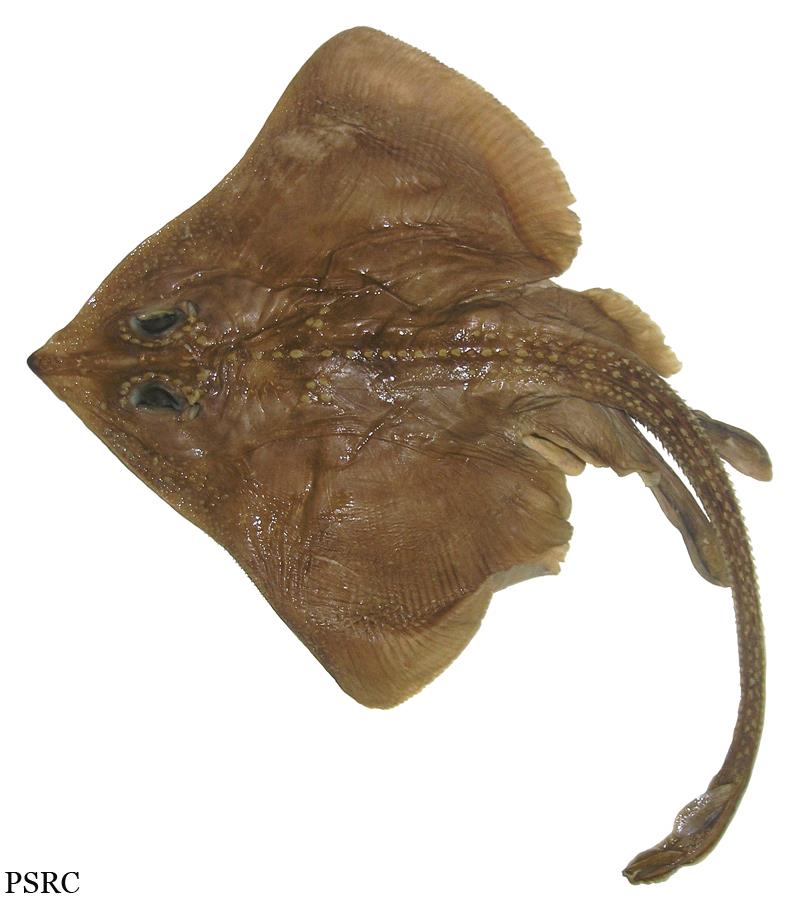Cruriraja hulleyi
Aschliman, Ebert & Compagno, 2010
Classification: Elasmobranchii Rajiformes Gurgesiellidae
Reference of the original description
A New Legskate (Rajoidei: Genus Cruriraja) from Southern Africa. Copeia, 2010(3), 364–372
A New Legskate (Rajoidei: Genus Cruriraja) from Southern Africa. Copeia, 2010(3), 364–372
Image of the original description
Image in copyright.
Image in copyright.
Description :
Citation: Cruriraja hulleyi Aschliman, Ebert & Compagno, 2010: In: Database of modern sharks, rays and chimaeras, www.shark-references.com, World Wide Web electronic publication, Version 04/2024
Please send your images of "Cruriraja hulleyi" to info@shark-references.com

Legskate, Cruriraja hulleyi Aschliman, Ebert & Compagno, 2010 © Pacific Shark Research Center at Moss Landing Marine Laboratories (MLML)

Legskate, Cruriraja hulleyi Aschliman, Ebert & Compagno, 2010 © Pacific Shark Research Center at Moss Landing Marine Laboratories (MLML)
Common names
Roughnose Legskate
Roughnose Legskate
Short Description
Original diagnosis after ASCHLIMAN, EBERT & COMPAGNO, 2010 [10243]: Distinct from congeners by exhibiting spatulate distal ends of the anterior pelvic lobes (wider tip in C. cadenati, tapering in others); dorsal mid-disk and tail with continuous semiparallel rows of thorns in adults (mid-disk lacking thorns in C. rugosa, thorns present on midline in others); claspers with small, flattened process (boss) on accessory terminal 2 cartilage and blind-ended sac with posterior opening at the distal end of the clasper (sentina), both unique within genus to C. hulleyi (Hulley, 1970, 1972); six interdorsal thorns (absent in C. durbanensis, two in C. parcomaculata [5triangularis], four in C. poeyi, one in C. rugosa, many in C. atlantis). Cruriraja hulleyi is further distinguished from congeners by the following combination of characters: interdorsal distance greater than half, and not exceeding, dorsal-fin base length (interdorsal distance at least 1.5 times dorsal-fin base length in C. atlantis, half or less dorsal-fin base length in C. parcomaculata); outer lateral margin of clasper dorsal marginal cartilage elongated and bluntly rounded (also in C. parcomaculata, but truncate in C. rugosa); proximal margin of dorsal terminal I cartilage forms a point (also in C. parcomaculata, but a series of points in C. rugosa); distal point (eperon) of ventral terminal cartilage relatively narrow and claw-like (bifurcate in C. parcomaculata, expanded in C. rugosa); ventral surface of clasper lacks dermal denticles (present in C. parcomaculata).
Original diagnosis after ASCHLIMAN, EBERT & COMPAGNO, 2010 [10243]: Distinct from congeners by exhibiting spatulate distal ends of the anterior pelvic lobes (wider tip in C. cadenati, tapering in others); dorsal mid-disk and tail with continuous semiparallel rows of thorns in adults (mid-disk lacking thorns in C. rugosa, thorns present on midline in others); claspers with small, flattened process (boss) on accessory terminal 2 cartilage and blind-ended sac with posterior opening at the distal end of the clasper (sentina), both unique within genus to C. hulleyi (Hulley, 1970, 1972); six interdorsal thorns (absent in C. durbanensis, two in C. parcomaculata [5triangularis], four in C. poeyi, one in C. rugosa, many in C. atlantis). Cruriraja hulleyi is further distinguished from congeners by the following combination of characters: interdorsal distance greater than half, and not exceeding, dorsal-fin base length (interdorsal distance at least 1.5 times dorsal-fin base length in C. atlantis, half or less dorsal-fin base length in C. parcomaculata); outer lateral margin of clasper dorsal marginal cartilage elongated and bluntly rounded (also in C. parcomaculata, but truncate in C. rugosa); proximal margin of dorsal terminal I cartilage forms a point (also in C. parcomaculata, but a series of points in C. rugosa); distal point (eperon) of ventral terminal cartilage relatively narrow and claw-like (bifurcate in C. parcomaculata, expanded in C. rugosa); ventral surface of clasper lacks dermal denticles (present in C. parcomaculata).
Distribution
Endemic to southern Africa, from Lüderitz, Namibia to Algoa Bay (and possibly East London) on the Eastern Cape coast of South Africa [10243]
Endemic to southern Africa, from Lüderitz, Namibia to Algoa Bay (and possibly East London) on the Eastern Cape coast of South Africa [10243]
Remarks
shark-references Species-ID=10162;
shark-references Species-ID=10162;
Parasites (arranged by Jürgen Pollerspöck)
Cestoda
Cestoda















